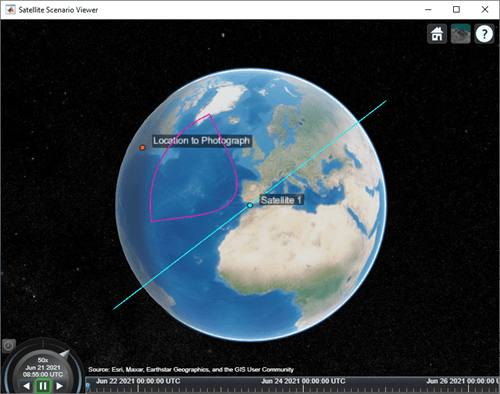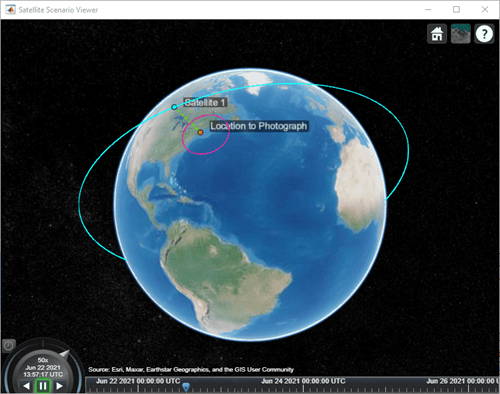conicalSensor
Description
conicalSensor( adds a parent)ConicalSensor object to
each parent in the vector parent using default parameters.
parent can be Satellite, GroundStation, Platform (Satellite Communications Toolbox), or
Gimbal.
conicalSensor(
adds conical sensors to the parents in parent,Name=Value)parent using additional
parameters specified by optional name-value arguments. For example,
'MaxViewAngle'=90 specifies a field of view angle of 90 degrees.
sensor = conicalSensor(___)sensor. Specify any input
argument combination from previous syntaxes.
Examples
Create a satellite scenario with a start time of 15-June-2021 8:55:00 AM UTC and a stop time of five days later. Set the simulation sample time to 60 seconds.
startTime = datetime(2021,6,21,8,55,0);
stopTime = startTime + days(5);
sampleTime = 60; % seconds
sc = satelliteScenario(startTime,stopTime,sampleTime)sc =
satelliteScenario with properties:
StartTime: 21-Jun-2021 08:55:00
StopTime: 26-Jun-2021 08:55:00
SampleTime: 60
AutoSimulate: 1
Satellites: [1×0 matlabshared.satellitescenario.Satellite]
GroundStations: [1×0 matlabshared.satellitescenario.GroundStation]
Platforms: [1×0 matlabshared.satellitescenario.Platform]
Viewers: [0×0 matlabshared.satellitescenario.Viewer]
AutoShow: 1
Add a satellite to the scenario using Keplerian orbital elements.
semiMajorAxis = 7878137; % meters eccentricity = 0; inclination = 50; % degrees rightAscensionOfAscendingNode = 0; % degrees argumentOfPeriapsis = 0; % degrees trueAnomaly = 50; % degrees sat = satellite(sc,semiMajorAxis,eccentricity,inclination,rightAscensionOfAscendingNode, ... argumentOfPeriapsis,trueAnomaly)
sat =
Satellite with properties:
Name: Satellite 1
ID: 1
ConicalSensors: [1x0 matlabshared.satellitescenario.ConicalSensor]
Gimbals: [1x0 matlabshared.satellitescenario.Gimbal]
Transmitters: [1x0 satcom.satellitescenario.Transmitter]
Receivers: [1x0 satcom.satellitescenario.Receiver]
Accesses: [1x0 matlabshared.satellitescenario.Access]
Eclipse: [1x0 Aero.satellitescenario.Eclipse]
GroundTrack: [1x1 matlabshared.satellitescenario.GroundTrack]
Orbit: [1x1 matlabshared.satellitescenario.Orbit]
CoordinateAxes: [1x1 matlabshared.satellitescenario.CoordinateAxes]
OrbitPropagator: sgp4
MarkerColor: [0.059 1 1]
MarkerSize: 6
ShowLabel: true
LabelFontColor: [1 1 1]
LabelFontSize: 15
Visual3DModel:
Visual3DModelScale: 1
Add a ground station, which represents the location to be photographed, to the scenario.
gs = groundStation(sc,Name="Location to Photograph", ... Latitude=42.3001,Longitude=-71.3504) % degrees
gs =
GroundStation with properties:
Name: Location to Photograph
ID: 2
Latitude: 42.3001 degrees
Longitude: -71.3504 degrees
Altitude: 0 meters
MinElevationAngle: 0 degrees
ConicalSensors: [1x0 matlabshared.satellitescenario.ConicalSensor]
Gimbals: [1x0 matlabshared.satellitescenario.Gimbal]
Transmitters: [1x0 satcom.satellitescenario.Transmitter]
Receivers: [1x0 satcom.satellitescenario.Receiver]
Accesses: [1x0 matlabshared.satellitescenario.Access]
Eclipse: [1x0 Aero.satellitescenario.Eclipse]
CoordinateAxes: [1x1 matlabshared.satellitescenario.CoordinateAxes]
MarkerColor: [1 0.4118 0.1608]
MarkerSize: 6
ShowLabel: true
LabelFontColor: [1 1 1]
LabelFontSize: 15
Add a gimbal to the satellite. You can steer this gimbal independently of the satellite.
g = gimbal(sat)
g =
Gimbal with properties:
Name: Gimbal 3
ID: 3
MountingLocation: [0; 0; 0] meters
MountingAngles: [0; 0; 0] degrees
ConicalSensors: [1x0 matlabshared.satellitescenario.ConicalSensor]
Transmitters: [1x0 satcom.satellitescenario.Transmitter]
Receivers: [1x0 satcom.satellitescenario.Receiver]
CoordinateAxes: [1x1 matlabshared.satellitescenario.CoordinateAxes]
Track the location to be photographed using the gimbal.
pointAt(g,gs);
Add a conical sensor to the gimbal. This sensor represents the camera. Set the field of view to 60 degrees.
camSensor = conicalSensor(g,MaxViewAngle=60)
camSensor =
ConicalSensor with properties:
Name: Conical sensor 4
ID: 4
MountingLocation: [0; 0; 0] meters
MountingAngles: [0; 0; 0] degrees
MaxViewAngle: 60 degrees
Accesses: [1x0 matlabshared.satellitescenario.Access]
FieldOfView: [0x0 matlabshared.satellitescenario.FieldOfView]
CoordinateAxes: [1x1 matlabshared.satellitescenario.CoordinateAxes]
Add access analysis to the conical sensor between the camera and the location to be photographed.
ac = access(camSensor,gs)
ac =
Access with properties:
Sequence: [4 2]
LineWidth: 3
LineColor: [0.3922 0.8314 0.0745]
Visualize the field of view of the camera by using the Satellite Scenario Viewer.
v = satelliteScenarioViewer(sc); fieldOfView(camSensor);

Determine the intervals during which the camera can see the geographical site.
t = accessIntervals(ac)
t=35×8 table
Source Target IntervalNumber StartTime EndTime Duration StartOrbit EndOrbit
__________________ ________________________ ______________ ____________________ ____________________ ________ __________ ________
"Conical sensor 4" "Location to Photograph" 1 21-Jun-2021 10:38:00 21-Jun-2021 10:55:00 1020 1 2
"Conical sensor 4" "Location to Photograph" 2 21-Jun-2021 12:36:00 21-Jun-2021 12:58:00 1320 2 3
"Conical sensor 4" "Location to Photograph" 3 21-Jun-2021 14:37:00 21-Jun-2021 15:01:00 1440 3 4
"Conical sensor 4" "Location to Photograph" 4 21-Jun-2021 16:41:00 21-Jun-2021 17:04:00 1380 5 5
"Conical sensor 4" "Location to Photograph" 5 21-Jun-2021 18:44:00 21-Jun-2021 19:07:00 1380 6 6
"Conical sensor 4" "Location to Photograph" 6 21-Jun-2021 20:46:00 21-Jun-2021 21:08:00 1320 7 7
"Conical sensor 4" "Location to Photograph" 7 21-Jun-2021 22:50:00 21-Jun-2021 23:04:00 840 8 8
"Conical sensor 4" "Location to Photograph" 8 22-Jun-2021 09:51:00 22-Jun-2021 10:02:00 660 13 13
"Conical sensor 4" "Location to Photograph" 9 22-Jun-2021 11:46:00 22-Jun-2021 12:07:00 1260 14 15
"Conical sensor 4" "Location to Photograph" 10 22-Jun-2021 13:46:00 22-Jun-2021 14:10:00 1440 15 16
"Conical sensor 4" "Location to Photograph" 11 22-Jun-2021 15:49:00 22-Jun-2021 16:13:00 1440 16 17
"Conical sensor 4" "Location to Photograph" 12 22-Jun-2021 17:53:00 22-Jun-2021 18:16:00 1380 18 18
"Conical sensor 4" "Location to Photograph" 13 22-Jun-2021 19:55:00 22-Jun-2021 20:18:00 1380 19 19
"Conical sensor 4" "Location to Photograph" 14 22-Jun-2021 21:58:00 22-Jun-2021 22:16:00 1080 20 20
"Conical sensor 4" "Location to Photograph" 15 23-Jun-2021 10:56:00 23-Jun-2021 11:16:00 1200 26 27
"Conical sensor 4" "Location to Photograph" 16 23-Jun-2021 12:56:00 23-Jun-2021 13:19:00 1380 27 28
⋮
Calculate the maximum revisit time in hours.
startTimes = t.StartTime;
endTimes = t.EndTime;
revisitTimes = hours(startTimes(2:end) - endTimes(1:end-1));
maxRevisitTime = max(revisitTimes) % hoursmaxRevisitTime = 12.666666666666666
Visualize the revisit times that the camera photographs of the location.
play(sc);

Input Arguments
Element of scenario in which to add the conical sensor, specified as a scalar or vector of satellites, ground stations, platforms, or gimbals. The number of conical sensors to add is determined by the size of the inputs.
If
parentis a scalar, all conical sensors are added to the parent.If
parentis a vector of parents and the number of conical sensors specified is one, that conical sensor is added to each parent.If
parentis a vector of parents and the number of conical sensors specified is more than one, the number of conical sensors must equal the number of parents inparentand each parent gets one conical sensor.
Name-Value Arguments
Specify optional pairs of arguments as
Name1=Value1,...,NameN=ValueN, where Name is
the argument name and Value is the corresponding value.
Name-value arguments must appear after other arguments, but the order of the
pairs does not matter.
Before R2021a, use commas to separate each name and value, and enclose
Name in quotes.
Example: 'MountingAngle'=[20;35;10] sets the yaw, pitch, and roll
angles of the conical sensor to 20, 35, and 10 degrees, respectively.
Note
The size of the name-value arguments defines the number of conical sensors that you can specify. To understand how to specify multiple conical sensors, refer to these properties.
You can set this property only when calling the conicalSensor
function. After you call the conicalSensor function, this
property is read-only.
Conical sensor name, specified as a name-value argument consisting of
'Name' and a string scalar, string vector, character vector, or
a cell array of character vectors.
If you are adding only one conical sensor, specify
Nameas a string scalar or a character vector.If you are adding multiple conical sensors, specify
Nameas a string scalar, character vector, string vector, or a cell array of character vectors. All conical sensors that you add as a string scalar or a character vector are assigned the same specified name. The number of elements in the string vector or cell array of character vectors must equal the number of conical sensors that you are adding. Each conical sensor is assigned the corresponding name from the vector or cell array.
In the default value, idx is the ID assigned by the satellite scenario.
Data Types: char | string
Mounting location with respect to the parent object in meters, specified as a
three-element vector or a matrix. The position vector is specified in the
body frame of the input parent.
If you are adding one conical sensor,
MountingLocationis a three-element vector. The elements specify the x, y, and z components of the Cartesian coordinates in the body frame of conical sensor.If you are adding multiple conical sensors,
MountingLocationcan be a three-element vector or a matrix. When specified as a vector, the same set of mounting locations are assigned to all specified conical sensors. When specified as a matrix,MountingLocationmust contain three rows and the same number of columns as the conical sensors. The columns correspond to the mounting location of each specified conical sensor and the rows correspond to the mounting location coordinates in the parent body frame.
When the AutoSimulate property of the satellite scenario is
false, you can modify the
MountingLocation property only when SimulationStatus is NotStarted. You
can use the restart function to reset
SimulationStatus to
NotStarted, but doing so erases the simulation
data.
Data Types: double
Mounting orientation with respect to parent object in degrees, specified as a three-element row vector of positive numbers. The elements of the vector correspond to yaw, pitch, and roll, in that order. Yaw, pitch, and roll are positive rotations about the z-axis, intermediate y-axis, and intermediate x-axis of the parent.
If you are adding one conical sensor,
MountingAnglesis a three-element vector.If you are adding multiple conical sensors,
MountingAnglescan be a three-element vector or a matrix. When specified as a vector, the same set of mounting angles are assigned to all specified conical sensors. When specified as a matrix,MountingAnglesmust contain three rows and the same number of columns as the conical sensors. The columns correspond to the mounting angles of each specified conical sensor and the rows correspond to the yaw, pitch, and roll angles in the parent body frame.
When the AutoSimulate property of the satellite scenario is
false, you can modify the MountingAngles
property only when SimulationStatus is NotStarted. You can use the
restart function to
reset SimulationStatus to NotStarted, but doing
so erases the simulation data.
Example: [0; 30; 60]
Data Types: double
Field of view angle in degrees, specified as a scalar in the range [0, 180] or a vector.
If you add one conical sensor,
MaxViewAnglemust be a scalar.If you add multiple conical sensors,
MaxViewAnglecan be a scalar or a vector. WhenMaxViewAngleis a scalar, the same field of view angle is assigned to all conical sensors that you are adding. WhenMaxViewAngleis a vector, the length ofMaxViewAnglemust equal the number of conical sensors in the parent. Each element ofMaxViewAngleis assigned to the specified corresponding conical sensor.
When the AutoSimulate property of the satellite scenario is
false, you can modify MaxViewAngle while the
SimulationStatus is NotStarted or
InProgress.
Data Types: double
Output Arguments
Conical sensors attached to parent, returned as a row
vector.
When the AutoSimulate property of the satellite scenario is
false, you can call conicalSensor function only
when SimulationStatus is NotStarted. You can use the
restart function to
reset SimulationStatus to NotStarted, but doing so erases the
simulation data.
Version History
Introduced in R2021a
See Also
Objects
Functions
MATLAB Command
You clicked a link that corresponds to this MATLAB command:
Run the command by entering it in the MATLAB Command Window. Web browsers do not support MATLAB commands.
选择网站
选择网站以获取翻译的可用内容,以及查看当地活动和优惠。根据您的位置,我们建议您选择:。
您也可以从以下列表中选择网站:
如何获得最佳网站性能
选择中国网站(中文或英文)以获得最佳网站性能。其他 MathWorks 国家/地区网站并未针对您所在位置的访问进行优化。
美洲
- América Latina (Español)
- Canada (English)
- United States (English)
欧洲
- Belgium (English)
- Denmark (English)
- Deutschland (Deutsch)
- España (Español)
- Finland (English)
- France (Français)
- Ireland (English)
- Italia (Italiano)
- Luxembourg (English)
- Netherlands (English)
- Norway (English)
- Österreich (Deutsch)
- Portugal (English)
- Sweden (English)
- Switzerland
- United Kingdom (English)